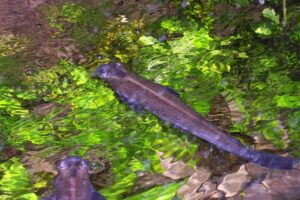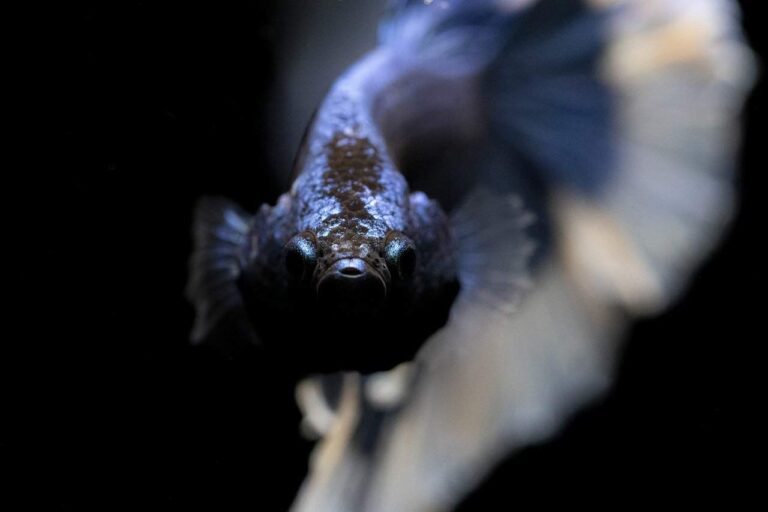Nature- it is quite a strange thing. There is perhaps no fish in the hobby for which the sentiment is more accurate than a fish called Anableps anableps. Unofficially, anableps is called the four-eyed fish, but does it really have quadrable assets for sight and vision? Not quite true. Each of the two eyes is divided by a strip of tissue into two sections, horizontally. Anableps is a perfect example of a natural adaptation that supplements the animal’s survival and lifestyle. The fish spends most of its life near the surface of water bodies, meaning its optical biology and vision are peculiarly adapted to the surface-dwelling needs.
So, what do the bifocals on anableps do? The dual vision enables our finny friend to search for food below the water surface and keep an eye on predators above, both simultaneously. It is believed that the ocular evolution of Anableps spans through millions of years and is dedicated to equipping the animal with better abilities to survive both aquatic and terrestrial habitats.
Among the three commonly recognized members of the species, the fish keeping community is more familiar with the variety called Anableps anableps, which can see above and below the water surface. In this post, we are profiling everything that makes Anableps an object of intrigue among fish hobbyists.
Anableps- Four-Eyed Fish Overview
| Family | Anablepidae |
| Natural Habitat | South America, Trinidad, Atlantic Coast |
| Care Level | Intermediate |
| Temperament | Peaceful |
| Diet | Carnivores (Mixed Diet) |
| Breeding | Livebearer, Mates by Direction |
| Lifespan | 6 to 8 years |
What is the Wild Habitat of Anableps?
Anableps are prevalent in the Central Region of the Atlantic coast, Trinidad, and South America, which is also the home to our personal favorite- the guppy fish. Mangrove swamps are the go-to habitat for the four-eyed wonder, which might confuse fish keepers hoping to create a freshwater aquarium setup for the fish.
The four-eyed fish is, in fact, a freshwater variety, but they are known to swim towards regions with brackish water where the salt concentrations change with every tide. Since they thrive well in waters with low salinity, a freshwater aquarium with a tinge of aquarium salt makes for a perfect habitat!
What Is the Best Diet for Anableps?
 In the natural habitat, the four-eyed fish prefers satiating their hunger by consuming smaller fish and other crustaceans, including mussels, snails, and worms. Live insects are a delicacy for Anableps. Using a mixed diet complements the health of the fish and supplements faster growth for the fry. Anableps is a surface dweller, meaning they are inclined to scavenge the water surface for nutrition. You can choose between a wide variety of floating fish flakes, pellets, and even sticks.
In the natural habitat, the four-eyed fish prefers satiating their hunger by consuming smaller fish and other crustaceans, including mussels, snails, and worms. Live insects are a delicacy for Anableps. Using a mixed diet complements the health of the fish and supplements faster growth for the fry. Anableps is a surface dweller, meaning they are inclined to scavenge the water surface for nutrition. You can choose between a wide variety of floating fish flakes, pellets, and even sticks.
Besides commercial fish food choices, you can offer frozen or live food, including brine shrimp, daphnia, and bloodworms. Once your Anableps get accustomed to feeding routines and the type of food, they readily accept whatever comes their way. Sure, the four-eyed fish is a rather humble being, but, as a fish keeper, it is essential to feed them protein-rich foods, without which they exhibit signs of stunted growth and stress.
Best Fish Tank Set Up for the Four-eyed Fish
Anableps is a hardy fish enabling fish keepers with some experience to maintain a well-balanced and long-lasting fish tank. However, our finny friend’s peculiar nature and the preference for a brackish habitat warrants research on the part of their fish keepers. Adult anableps can grow up to a foot in length, and they are known to spend an active life, continually skimming through water surface in search of food and predators.
The length and depth of the fish tank are equally crucial for the four-eyed fish. The fish are also well known to be skilled jumpers, which is why you need a reliable and compressed fish tank cover. Following their jumping skills, the length from the top of the fish tank up to the water level needs to be at least 12 inches long. Similarly, the total depth of the aquarium should be 24 inches. It is best to landscape the fish tank with a mix of gravel, bogwood, and smooth rocks.
Much like any other freshwater aquarium fish, maintaining the right water parameters is vital to keep your four-eyed fish anableps in a freshwater tank, happy and healthy.
Optimal Fish Tank Parameters For Anableps
In case you are not much of a reader, here is a brief list of the optimal fish tank parameters to keep your anableps healthy and happy:
- Minimum Tank Size (Juvenile Anableps)– 65 to 75 gallons
- Minimum Tank Size (Adult Anableps)– 125 gallons
- Optimal Water Temperature Range– 75-to-87-degree Fahrenheit
- Optimal Water pH Range– 7.0 to 8.5
- Water Hardiness– 10 to 25 dGH
As we mentioned before, Anableps have a high affinity to freshwater and brackish living conditions. Employing aquarium salt to simulate situations similar to their natural habitats helps the fish to thrive better. Adding two teaspoons worth of aquarium salt for every four gallons of water is a good amount.
Because the four-eyed fish’s bioload is quite a lot, conducting 20 percent water changes every two weeks is essential to keep the harmful gases, including nitrates, from accumulating. Your Anableps aquarium cannot survive without a robust and powerful filtration system. If you support an Anableps exclusive fish tank, then the recommended male to female ratio is 1:1.
If you hope to create a planted Anableps fish tank, you will most likely find yourself in a bit of a pickle. The four-eyed fish can do just fine without plants, but they also don’t mind having a few to play around with. The issue is that it is much harder to find hardy plants that can survive brackish water conditions. Some vigorous aquarium plants that might live through the test of salinity and time include- Java Fern and Anubias.

Can You Keep Anableps in a Community Fish Tank?
Are Anableps aggressive? Not really. Anableps is surprisingly a peaceful, non-aggressive fish and adapt well to the other tank inhabitants in a community aquarium. However, like we always say, if a fish is small enough to fit into the mouth of a large fish, it will most likely end up there! The sentiment is right for our four-eyed fish too. Another important consideration before bringing in the finny friends is to understand that anableps is a schooling fish variety. Meaning, they thrive well in groups of 6 or more other family members.
Best tank mates for anableps community fish tank include goby fish (bottom-dwelling variety), mudskippers, orange Cichlids, and Sailfin Mollies. Other brackish aquarium loving fish types such as Monodactylus and Archerfish too make good tank neighbors for anableps. However, both fish can grow up to be colossally large, needing a separate tank.
How Do You Identify Genders in Anableps?
A female Anableps is bulkier and more extensive than the full-grown males, which is comparatively slender. The female reaches a full length of 12 inches, while the male gets a little short of 8 inches. Upon reaching complete maturity, the anal fin of the male Anableps morphs into a gonopodium.

The Curious Case of Anableps Fish Breeding
The surface area of the fish tank is an essential factor when it comes to breeding and reproduction. A young four-eyed fish typically reaches sexual maturity by eight months. At this stage of their lives, the fish is around 6 inches in length.
Another critical factor to note here is that Anableps is a livebearer fish. Among the lot, the male gonopodium and the female genitalia can be located on the fish’s right and left sides. The peculiar breeding patterns are dictated via direction, meaning the left-sided male will always breed with a right-sided female.
The length of the gestation period can last up to 2 months. The gestation period’s duration is directly affected by factors including- water temperature, quality of food, and stress levels—every breeding cycle for the Anableps fish results in 10 to 15 fish fry. If you have never dealt with large freshwater fish, you will be amazed at the size of Anableps babies right after birth, coming out around 2 to 2.8 inches long. The young fry needs ample space to move around and find reprieve, which explains the large surface area needs within the tank.
Is Anableps the Right Fish for Your Aquarium?
Keeping Anableps can be a meaningful upgrade for both intermediate and expert fish keepers. Yes, they are hardy and adapt quickly to a well-maintained environment; we recommend gaining some experience with other low maintenance freshwater fish species before jumping on to Anableps. The fish grows a significant size, and they prefer to live in groups, not to mention their jumping instincts are quite strong.
The entirety of the fish tank set up for Anableps is rather specialized, with the requirement to maintain brackish shallow water conditions. Conclusively, Anableps is a treat to own but extremely tricky when it comes to breeding and retaining the right water parameters.





